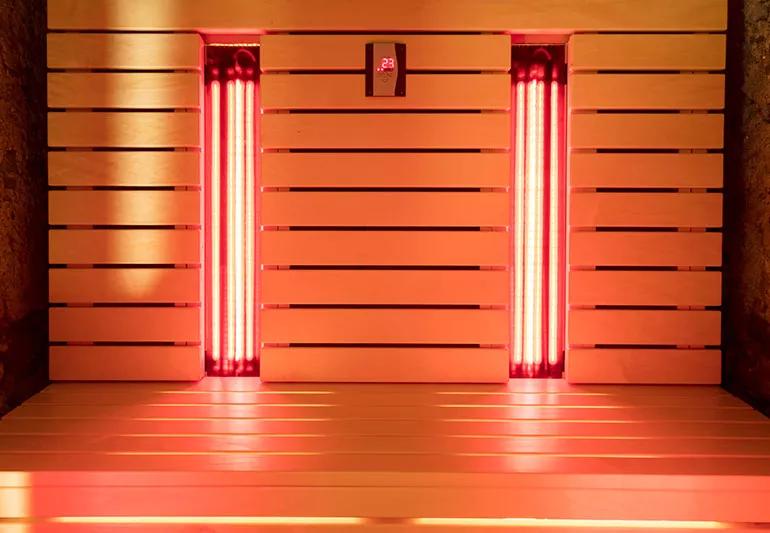This modern twist on a traditional sauna offers a lower-temperature option

Facts are facts, so let’s get one thing straight: Infrared saunas are definitely “cooler” than more traditional saunas that date back to ancient times.
Advertisement
Cleveland Clinic is a non-profit academic medical center. Advertising on our site helps support our mission. We do not endorse non-Cleveland Clinic products or services. Policy
Instead of steam or flame-stoked heat, infrared saunas use infrared lamps and electromagnetic magic to create warmth. The process allows infrared saunas to operate at a lower temperature while still providing therapeutic benefits.
Consider it a modern twist on how our ancestors sweated their way to better health and wellness. To learn more about this plug-it-in approach, we turn to functional medicine specialist Melissa Young, MD.
Light panels do more than give infrared saunas a unique glow. They also heat things up in a completely different way than old-school saunas, which is really what sets this method apart, says Dr. Young.
The lamps in infrared saunas focus a penetrating warmth directly on your skin to bring heat-therapy benefits. Traditional methods crank up the air temperature within an entire sauna.
Those two approaches bring up vastly different readings on thermometers. Temperatures in infrared saunas typically land between 110 degrees Fahrenheit and 135 F (43.33 degrees Celsius and 57.22 C). A traditional sauna usually falls between 150 F and 195 F (65.55 C and 90.55 C).
“Infrared saunas can definitely be much more comfortable for people while delivering the same sort of benefits,” says Dr. Young.
Advertisement
So, why should you lounge under infrared lights in temperatures that still approach the highest ever recorded on Earth? (If you’re curious, the much-disputed world record is just above 130 F [54.44 C].)
Here are a few reasons to get sweaty under the lights.
Within minutes of sitting in an infrared sauna, your body’s natural response begins. Beads of sweat appear on your skin. Your blood vessels widen and increase blood flow. Your heart rate ticks up.
“What’s happening mimics exercise when you think of the physiology,” explains Dr. Young. “There’s a benefit to that.”
Studies show that infrared saunas can help boost heart health and reduce blood pressure. Researchers equated the physical response of an infrared sauna session to walking at a moderate pace.
The improved blood circulation brought on by an infrared sauna session can help speed up muscle recovery following physical activity, says Dr. Young. Regular use may even help athletes improve performance.
Researchers found that infrared sauna therapy “may be a promising method for treatment of chronic pain.” The determination followed a two-year study where people showed improved outcomes with the treatment.
Warming your body seems to warm your soul, too. Setting aside some sauna time may help decrease depression, anxiety and stress. Basically, think of it as a meditation session in warmer temperatures.
A bonus benefit to being more relaxed? Better sleep, which has also been linked to sauna use.
There’s evidence that regular sauna use can help you avoid the common cold, says Dr. Young. Saunas also reduce oxidative stress, which is associated with cardiovascular disease, cancer and degenerative diseases like dementia.
More controversial are claims that sauna use can provide a detoxification effect as you sweat out toxins such as cadmium and lead. “That research is still in its infancy,” cautions Dr. Young.
So, you want to give an infrared hot box a try? Dr. Young offers these recommendations:
Advertisement
Sauna use is viewed as a safe activity, which explains why they’ve been around for thousands of years. But be aware of the potential for dehydration, says Dr. Young. If you suddenly feel dizzy or nauseated, get out of the sauna immediately.
You also may want to avoid using infrared saunas in certain situations, including if:
If you have any pre-existing medical conditions, check with your healthcare provider before starting an infrared sauna routine, advises Dr. Young.
Absolutely, says Dr. Young. “We see so many people who come in asking how they can move towards optimal health,” she says. “With saunas in general, and especially infrared saunas, people feel better after using them. It can be an integral part of your health practices.”
Advertisement
Learn more about our editorial process.
Advertisement

Bleeding is a risk and warrants taking care, but the reward of this lifesaving medication is great

Severe and debilitating headaches can affect the quality of your child’s life

With repeat injections over time, you may be able to slow the development of new wrinkles

Although it can be alarming, it’s normal to experience blood clots during menstruation

Stretch before heading outside, keep proper form and avoid jerking or twisting to throw snow

Type 2 diabetes isn’t inevitable with these dietary changes

Applying a hot or cold compress can help with pain